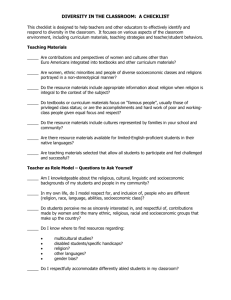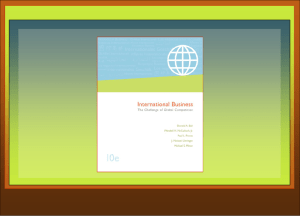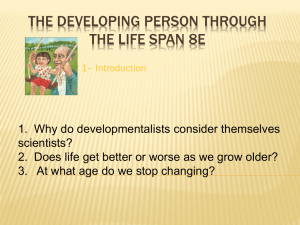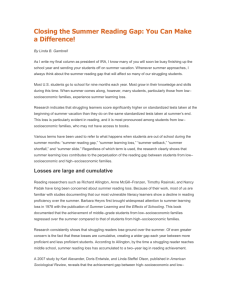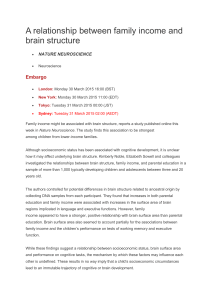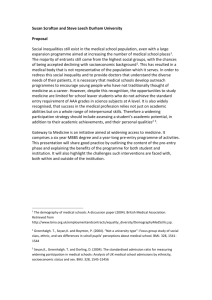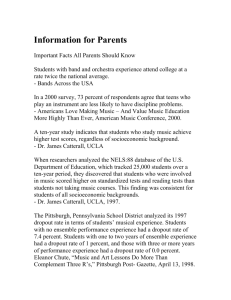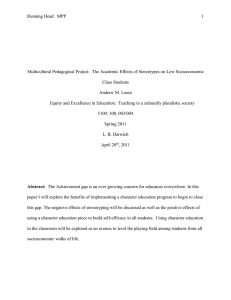Socioeconomic Status and Health Differentials in China
advertisement
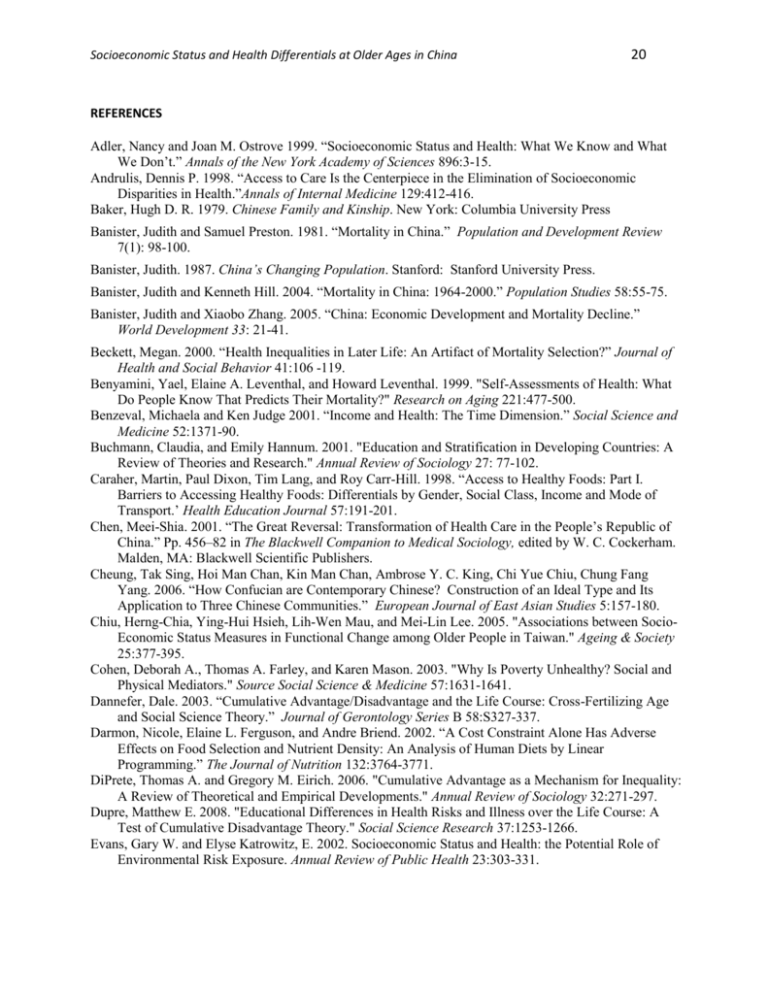
Socioeconomic Status and Health Differentials at Older Ages in China 20 REFERENCES Adler, Nancy and Joan M. Ostrove 1999. “Socioeconomic Status and Health: What We Know and What We Don’t.” Annals of the New York Academy of Sciences 896:3-15. Andrulis, Dennis P. 1998. “Access to Care Is the Centerpiece in the Elimination of Socioeconomic Disparities in Health.”Annals of Internal Medicine 129:412-416. Baker, Hugh D. R. 1979. Chinese Family and Kinship. New York: Columbia University Press Banister, Judith and Samuel Preston. 1981. “Mortality in China.” Population and Development Review 7(1): 98-100. Banister, Judith. 1987. China’s Changing Population. Stanford: Stanford University Press. Banister, Judith and Kenneth Hill. 2004. “Mortality in China: 1964-2000.” Population Studies 58:55-75. Banister, Judith and Xiaobo Zhang. 2005. “China: Economic Development and Mortality Decline.” World Development 33: 21-41. Beckett, Megan. 2000. “Health Inequalities in Later Life: An Artifact of Mortality Selection?” Journal of Health and Social Behavior 41:106 -119. Benyamini, Yael, Elaine A. Leventhal, and Howard Leventhal. 1999. "Self-Assessments of Health: What Do People Know That Predicts Their Mortality?" Research on Aging 221:477-500. Benzeval, Michaela and Ken Judge 2001. “Income and Health: The Time Dimension.” Social Science and Medicine 52:1371-90. Buchmann, Claudia, and Emily Hannum. 2001. "Education and Stratification in Developing Countries: A Review of Theories and Research." Annual Review of Sociology 27: 77-102. Caraher, Martin, Paul Dixon, Tim Lang, and Roy Carr-Hill. 1998. “Access to Healthy Foods: Part I. Barriers to Accessing Healthy Foods: Differentials by Gender, Social Class, Income and Mode of Transport.’ Health Education Journal 57:191-201. Chen, Meei-Shia. 2001. “The Great Reversal: Transformation of Health Care in the People’s Republic of China.” Pp. 456–82 in The Blackwell Companion to Medical Sociology, edited by W. C. Cockerham. Malden, MA: Blackwell Scientific Publishers. Cheung, Tak Sing, Hoi Man Chan, Kin Man Chan, Ambrose Y. C. King, Chi Yue Chiu, Chung Fang Yang. 2006. “How Confucian are Contemporary Chinese? Construction of an Ideal Type and Its Application to Three Chinese Communities.” European Journal of East Asian Studies 5:157-180. Chiu, Herng-Chia, Ying-Hui Hsieh, Lih-Wen Mau, and Mei-Lin Lee. 2005. "Associations between SocioEconomic Status Measures in Functional Change among Older People in Taiwan." Ageing & Society 25:377-395. Cohen, Deborah A., Thomas A. Farley, and Karen Mason. 2003. "Why Is Poverty Unhealthy? Social and Physical Mediators." Source Social Science & Medicine 57:1631-1641. Dannefer, Dale. 2003. “Cumulative Advantage/Disadvantage and the Life Course: Cross-Fertilizing Age and Social Science Theory.” Journal of Gerontology Series B 58:S327-337. Darmon, Nicole, Elaine L. Ferguson, and Andre Briend. 2002. “A Cost Constraint Alone Has Adverse Effects on Food Selection and Nutrient Density: An Analysis of Human Diets by Linear Programming.” The Journal of Nutrition 132:3764-3771. DiPrete, Thomas A. and Gregory M. Eirich. 2006. "Cumulative Advantage as a Mechanism for Inequality: A Review of Theoretical and Empirical Developments." Annual Review of Sociology 32:271-297. Dupre, Matthew E. 2008. "Educational Differences in Health Risks and Illness over the Life Course: A Test of Cumulative Disadvantage Theory." Social Science Research 37:1253-1266. Evans, Gary W. and Elyse Katrowitz, E. 2002. Socioeconomic Status and Health: the Potential Role of Environmental Risk Exposure. Annual Review of Public Health 23:303-331. Socioeconomic Status and Health Differentials at Older Ages in China 21 Feinstein, Jonathan S. 1993. “The Relationship Between Socioeconomic Status and Health.” Milbank Quarterly 71:279-322. Ferraro, Kenneth F. and Jessica A. Kelley-Moore. 2003. “Cumulative Disadvantage and Health: Longterm Consequences of Obesity? American Sociological Review 68:707–729. George, Linda K. 2005. “Socioeconomic Status and Health Across the Life Course: Progress and Prospects.”Journal of Gerontology B60:S135-139. Goldman, Dana and James P. Smith 2002. “Can Patient Self-Management Help Explain the SES Health Gradient?” Proceedings of the National Academy of Sciences of the United States of America 99: 109-129. Hannum, Emily. 1999. “Political Change and the Urban-Rural Gap in Basic Education in China, 19491990.” Comparative Education Review 43:193-211. Hayflick, Leonard. 1998. “How and Why We Age.” Experimental Gerontology 33:639-653. Hayward, Rodney A., Martin F. Shapiro, Howard E. Freeman, and Christopher R. Corey. 1988. “Who Gets Screened for Cervical and Breast Cancer? Results from a New National Survey.” Archives of Internal Medicine 148:1177-1181. Herd, Pamela, Brian Goesling, and James S. House. 2007. "Socioeconomic Position and Health: The Differential Effects of Education versus Income on the Onset versus Progression of Health Problems." Journal of Health and Social Behavior 48:223-238. House, James S. 2002. "Understanding Social Factors and Inequalities in Health: 20th Century Progress and 21st Century Prospects." Journal of Health and Social Behavior 43:125-142.House, James S., Paula M. Lantz, and P. Herd. 2005. "Continuity and Change in the Social Stratification of Aging and Health over the Life Course: Evidence from a Nationally Representative Longitudinal Study from 1986 to 2001/2002 (Americans' Changing Lives Study)." Journals of Gerontology Series BPsychological Sciences and Social Sciences, 60:15-26. House, James S., James M. Lepkowski, Ann M. Kinney, Richard P. Mero, Ronald C. Kessler, and A. Regula Herzog. 1994. "The Social Stratification of Aging and Health." Journal of Health and Social Behavior 35:213-234. House, James S., Ronald C. Kessler, A. Regula Herzog, Richard P. Mero, Ann M. Kinney, and Martha J. Breslow. 1990. "Age, Socioeconomic Status, and Health." The Milbank Quarterly 68:383-411. Idler, Ellen L. and Stanislav V. Kasl. 1995. “Self-Ratings of Health: Do They Also Predict Change in Functional Ability?” Journal of Gerontology Series B 50:S344-S353. Idler, Ellen L. and Yael Benyamini. 1997. "Self-Rated Health and Mortality: A Review of Twenty-Seven Community Studies." Journal of Health and Social Behavior 38:21-37. Jamison, Dean T., John R. Evans, Timothy King, and Ian Porter. 1984. China, the Health Sector. Washington, D.C.: World Bank. Jatrana, Santosh and Angelique Chan. 2007. “Do Socioeconomic Effects on Health Diminish with Age? A Singapore Case Study.” Journal of Cross-Cultural Gerontology 22:287–301. Kanbur, Kavi and Xiaobo Zhang. 1999. Which Regional Inequality? The Evolution of Rural–Urban and Inland–Coastal Inequality in China from 1983 to 1995.” Journal of Comparative Economics 27: 686–701. Kitagawa, E.M. and P.M. Hauser. 1973. Differential Mortality in the United States: A Study in Socioeconomic Epidemiology. Cambridge, MA: Harvard University Press. Lantz, Paula M., James S. House; James M. Lepkowski; David R. Williams; Richard P. Mero; Jieming Chen. 1998. “Socioeconomic Factors, Health Behaviors, and Mortality: Results From a Nationally Representative Prospective Study of US Adults.” JAMA 279:1703-1708. Lauderdale, Diane S. 2001. “Education and Survival: Birth Cohort, Period, and Age Effects.”Demography 38:551-61.
